Compressive Behavior, Microstructural Properties, and Freeze–Thaw Behavior of Tailing Recycled Aggregate Concrete with Waste Polypropylene Fiber Addition
Abstract
:1. Introduction
2. Materials and Methods
2.1. Materials
2.2. Mixture Proportion and Specimen Preparation
2.3. Experimental Program
3. Result and Discussion
3.1. Stress–Strain Curve
3.2. Parameters of Stress–Strain Curve
3.2.1. Peak Stress
3.2.2. Peak Strain
3.2.3. Elastic Modulus
3.2.4. Energy Absorption Capacity
3.3. The Non-Dimensional Stress–Strain Curves
3.4. Microstructure
3.5. Freeze–Thaw Resistance
3.5.1. Weight Loss Rate
3.5.2. Relative Compressive Strength
3.5.3. Relative Dynamic Modulus of Elasticity
4. Conclusions
- Adding PPF widened the transition area of the stress–strain curves, which was accompanied by improved ductility.
- As the content of the PPF increased, the peak stress and energy absorption capacity first increased and then decreased, reaching their maximum values at 0.6% content of PPF. However, the effects of PPF on peak stress were not significant. At the same time, it was also found that the peak strains were significantly higher in the TRAC-PP series than in the control group, while the elastic modulus were lower in the TRAC-PP series than in the control group.
- The stress–strain curves of TRAC-PP were considerably influenced by the content of the PPF. A segmented constitutive model was proposed for the stress–strain curves of TRAC-PP with different PPF content. The calculated curves are in good agreement with the experimental curves.
- The microstructure of TRAC appeared dense enough. We experimentally found that there were a large amount of C-S-H gel and needle-like ettringite near the IOTs. Meanwhile, a large number of AFm was observed in the ITZ around the IOT particles, and this was known to be beneficial for the macro strength. In addition, a few micro-cracks were found on the IOT surface, which might partially explain the decreased strength as a result of excess use of IOTs.
- Attached dense hydration products on the PPF surface and the phenomenon of fiber yielding represented fiber would consume energy during the pull-out process. Throughout the cracking process, the fibers transferred the load to the matrix around the fibers by bridging micro-cracks, thus effectively enhancing the strength and energy absorption capacity of concrete. The results of SEM analysis were consistent with those observed in macroscopic mechanical tests.
- The incorporation of small amounts of PPF into TRAC was advantageous for reducing the damage caused by the freeze–thaw process on the cement matrix. The freeze–thaw resistance first increased and then decreased with increasing PPF content. Additionally, PPF effects were more significant on weight loss rate than relative compressive strength and RDEM. The experimental results demonstrated that the best freeze–thaw resistance was obtained for TRAC-PP with 0.3–0.6% content of PPF. A solid waste utilization rate should be maximized while guaranteeing the mechanical properties and durability. Thus, it was suggested that the content of PPF in TRAC-PP should be 0.6%.
Author Contributions
Funding
Conflicts of Interest
Abbreviations
| TRAC | recycled aggregate concrete containing iron ore tailings |
| PPF | polypropylene fiber |
| TRAC-PP | fiber-reinforced tailings recycled aggregate concrete |
| IOTs | iron ore tailings |
| NCA | natural coarse aggregate |
| RCA | recycled coarse aggregates |
| RAC | recycled aggregate concrete |
| ITZ | interfacial transition zone |
| SEM | scanning electron microscopy |
| RDEM | relative dynamic modulus of elasticity |
| C-S-H | calcium silicate hydrate |
| AFm | monosulfate calcium sulfoaluminate hydrates |
References
- Pazdera, L.; Cajka, R.; Topolar, L.; Mateckova, P.; Bilek, V.; Sucharda, O. Measurement and utilization of acoustic emission for the analysis and monitoring of concrete slabs on the subsoil. Period. Polytech-Civ. 2019, 63, 608–620. [Google Scholar] [CrossRef]
- Shi, C.; Li, Y.; Zhang, J.; Li, W.; Chong, L.; Xie, Z. Performance enhancement of recycled concrete aggregate—A review. J. Clean. Prod. 2016, 112, 466–472. [Google Scholar] [CrossRef]
- Ferdous, W.; Manalo, A.; Siddique, R.; Mendis, P.; Zhuge, Y.; Wong, H.S. Recycling of landfill wastes (tyres, plastics and glass) in construction—A review on global waste generation, performance, application and future opportunities. Resour. Conserv. Recycl. 2021, 173, 105745. [Google Scholar] [CrossRef]
- Ferdous, W.; Manalo, A.; AlAjarmeh, O.S.; Zhuge, Y.; Mohammed, A.A.; Bai, Y. Bending and shear behaviour of waste rubber concrete-filled FRP tubes with external flanges. Polymers 2021, 13, 2500. [Google Scholar] [CrossRef]
- Singh, N.; Singh, S.P. Electrical resistivity of self consolidating concretes prepared with reused concrete aggregates and blended cements. J. Build. Eng. 2019, 25, 100780. [Google Scholar] [CrossRef]
- Arora, S.; Singh, B.; Bhardwaj, B. Strength performance of recycled aggregate concretes containing mineral admixtures and their performance prediction through various modeling techniques. J. Build. Eng. 2019, 24, 100741. [Google Scholar] [CrossRef]
- Deng, X.; Gao, X.; Wang, R.; Gao, M.; Yan, X.; Cao, W. Investigation of microstructural damage in air-entrained recycled concrete under a freeze–thaw environment. Constr. Build. Mater. 2021, 268, 121219. [Google Scholar] [CrossRef]
- Muduli, R.; Mukharjee, B.B. Performance assessment of concrete incorporating recycled coarse aggregates and metakaolin: A systematic approach. Constr. Build. Mater. 2020, 233, 17223. [Google Scholar] [CrossRef]
- Li, Y.; Wang, R.; Li, S.; Zhao, Y.; Qin, Y. Resistance of recycled aggregate concrete containing low- and high-volume fly ash against the combined action of freeze–thaw cycles and sulfate attack. Constr. Build. Mater. 2018, 166, 23–34. [Google Scholar] [CrossRef]
- Cai, L.; Ma, B.; Li, X.; Lv, Y.; Liu, Z.; Jian, S. Mechanical and hydration characteristics of autoclaved aerated concrete (AAC) containing iron-tailings: Effect of content and fineness. Constr. Build. Mater. 2016, 128, 361–372. [Google Scholar] [CrossRef]
- Shettima, A.U.; Hussin, M.W.; Ahmad, Y.; Mirza, J. Evaluation of iron ore tailings as replacement for fine aggregate in concrete. Constr. Build. Mater. 2016, 120, 72–79. [Google Scholar] [CrossRef]
- Fontes, W.C.; Mendes, J.C.; Da Silva, S.N.; Fiorotti Peixoto, R.A. Mortars for laying and coating produced with iron ore tailings from tailing dams. Constr. Build. Mater. 2016, 112, 988–995. [Google Scholar] [CrossRef]
- Xu, F.; Wang, S.; Li, T.; Liu, B.; Li, B.; Zhou, Y. The mechanical properties of tailing recycled aggregate concrete and its resistance to the coupled deterioration of sulfate attack and wetting–drying cycles. Structures 2020, 7, 2208–2216. [Google Scholar] [CrossRef]
- Xue, G.; Yilmaz, E.; Song, W.; Cao, S. Mechanical, flexural and microstructural properties of cement-tailings matrix composites: Effects of fiber type and dosage. Compos. Part B-Eng. 2019, 172, 131–142. [Google Scholar] [CrossRef]
- Awal, A.S.M.A.; Mohammadhosseini, H. Green concrete production incorporating waste carpet fiber and palm oil fuel ash. J. Clean. Prod. 2016, 137, 157–166. [Google Scholar] [CrossRef]
- Caggiano, A.; Gambarelli, S.; Martinelli, E.; Nistico, N.; Pepe, M. Experimental characterization of the post-cracking response in hybrid steel/polypropylene fiber-reinforced concrete. Constr. Build. Mater. 2016, 125, 1035–1043. [Google Scholar] [CrossRef]
- Aisyah, H.A.; Paridah, M.T.; Sapuan, S.M.; Ilyas, R.A.; Khalina, A.; Nurazzi, N.M. A comprehensive review on advanced sustainable woven natural fibre polymer composites. Polymers 2021, 13, 471. [Google Scholar] [CrossRef] [PubMed]
- Ahmed, W.; Lim, C.W. Production of sustainable and structural fiber reinforced recycled aggregate concrete with improved fracture properties: A review. J. Clean. Prod. 2021, 279, 123832. [Google Scholar] [CrossRef]
- Siskova, A.O.; Peer, P.; Andicsova, A.E.; Jordanov, I.; Rychter, P. Circulatory management of polymer waste: Recycling into fine fibers and their applications. Materials 2021, 14, 4694. [Google Scholar] [CrossRef]
- Babalola, O.E.; Awoyera, P.O.; Le, D.H.; Romero, L.M.B. A review of residual strength properties of normal and high strength concrete exposed to elevated temperatures: Impact of materials modification on behaviour of concrete composite. Constr. Build. Mater. 2021, 296, 123448. [Google Scholar] [CrossRef]
- Ahmed, H.U.; Faraj, R.H.; Hilal, N.; Mohammed, A.A.; Sherwani, A.F.H. Use of recycled fibers in concrete composites: A systematic comprehensive review. Compos. Part B-Eng. 2021, 215, 108769. [Google Scholar] [CrossRef]
- Sanjay, M.R.; Madhu, P.; Jawaid, M.; Senthamaraikannan, P.; Senthil, S.; Pradeep, S. Characterization and properties of natural fiber polymer composites: A comprehensive review. J. Clean. Prod. 2018, 172, 566–581. [Google Scholar] [CrossRef]
- Rahimi, A.; Garcia, J.M. Chemical recycling of waste plastics for new materials production. Nat. Rev. Chem. 2017, 1, 0046. [Google Scholar] [CrossRef]
- Ragaert, K.; Delva, L.; Van Geem, K. Mechanical and chemical recycling of solid plastic waste. Waste Manag. 2017, 69, 24–58. [Google Scholar] [CrossRef]
- Chen, X.; Shi, X.; Zhou, J.; Chen, Q.; Li, E.; Du, X. Compressive behavior and microstructural properties of tailings polypropylene fibre-reinforced cemented paste backfill. Constr. Build. Mater. 2018, 190, 211–221. [Google Scholar] [CrossRef]
- Malek, M.; Jackowski, M.; Lasica, W.; Kadela, M. Characteristics of recycled polypropylene fibers as an addition to concrete fabrication based on portland cement. Materials 2020, 13, 1827. [Google Scholar] [CrossRef] [Green Version]
- Jiang, P.; Zhou, L.; Wang, Y.; Qian, B.; Wang, W.; Li, N. Freeze-thaw damage model of polypropylene fiber reinforced cement stabilized waste construction slurry under uniaxial action. Minerals 2021, 11, 743. [Google Scholar] [CrossRef]
- Zhou, L.; Guo, S.; Zhang, Z.; Shi, C.; Jin, Z.; Zhu, D. Mechanical behavior and durability of coral aggregate concrete and bonding performance with fi ber-reinforced polymer (FRP) bars: A critical review. J. Clean. Prod. 2021, 289, 125652. [Google Scholar] [CrossRef]
- Zhang, S.P.; Zhao, B.H. Influence of polypropylene fibre on the mechanical performance and durability of concrete materials. Eur. J. Environ. Civ. Eng. 2012, 16, 1269–1277. [Google Scholar] [CrossRef]
- Boz, A.; Sezer, A. Influence of fiber type and content on freeze-thaw resistance of fiber reinforced lime stabilized clay. Cold Reg. Sci. Technol. 2018, 151, 359–366. [Google Scholar] [CrossRef]
- Xu, F.; Wang, S.; Li, T.; Liu, B.; Li, B.; Zhou, Y. Mechanical properties and pore structure of recycled aggregate concrete made with iron ore tailings and polypropylene fibers. J. Build. Eng. 2021, 33, 101572. [Google Scholar] [CrossRef]
- Xu, F.; Wang, S.; Li, T.; Liu, B.; Zhao, N.; Liu, K. The mechanical properties and resistance against the coupled deterioration of sulfate attack and freeze-thaw cycles of tailing recycled aggregate concrete. Constr. Build. Mater. 2020, 10, 121273. [Google Scholar] [CrossRef]
- Li, T.; Wang, S.; Xu, F.; Meng, X.; Li, B.; Zhan, M. Study of the basic mechanical properties and degradation mechanism of recycled concrete with tailings before and after carbonation. J. Clean. Prod. 2020, 259, 13. [Google Scholar] [CrossRef]
- Zhang, P.; Li, Q.-f. Effect of polypropylene fiber on durability of concrete composite containing fly ash and silica fume. Compos. Part B-Eng. 2013, 45, 1587–1594. [Google Scholar] [CrossRef]
- Guo, L.; Wu, Y.; Xu, F.; Song, X.; Ye, J.; Duan, P. Sulfate resistance of hybrid fiber reinforced metakaolin geopolymer composites. Compos. Part B-Eng. 2020, 183, 107689. [Google Scholar] [CrossRef]
- Zhong, H.; Zhang, M. Experimental study on engineering properties of concrete reinforced with hybrid recycled tyre steel and polypropylene fibres. J. Clean. Prod. 2020, 259, 15. [Google Scholar] [CrossRef]
- Yuan, H.Q.; Jiang, Y.B.; Cui, Y.L.; Zhou, H. Permeability and compressive strength of recycled aggregate permeable concrete. Mater. Rep. 2018, 32, 466–470. [Google Scholar]
- Zhao, S.; Fan, J.; Sun, W. Utilization of iron ore tailings as fine aggregate in ultra-high performance concrete. Constr. Build. Mater. 2014, 50, 540–548. [Google Scholar] [CrossRef]
- Duan, P.; Yan, C.J.; Zhou, W.; Ren, D.M. Fresh properties, compressive strength and microstructure of fly ash geopolymer paste blended with iron ore tailing under thermal cycle. Constr. Build. Mater. 2016, 118, 76–88. [Google Scholar] [CrossRef]
- Sleiman, H.; Perrot, A.; Amziane, S. A new look at the measurement of cementitious paste setting by Vicat test. Cem. Concr. Res. 2010, 40, 681–686. [Google Scholar] [CrossRef]
- Somna, K.; Jaturapitakkul, C.; Kajitvichyanukul, P.; Chindaprasirt, P. NaOH-activated ground fly ash geopolymer cured at ambient temperature. Fuel 2011, 90, 2118–2124. [Google Scholar] [CrossRef]
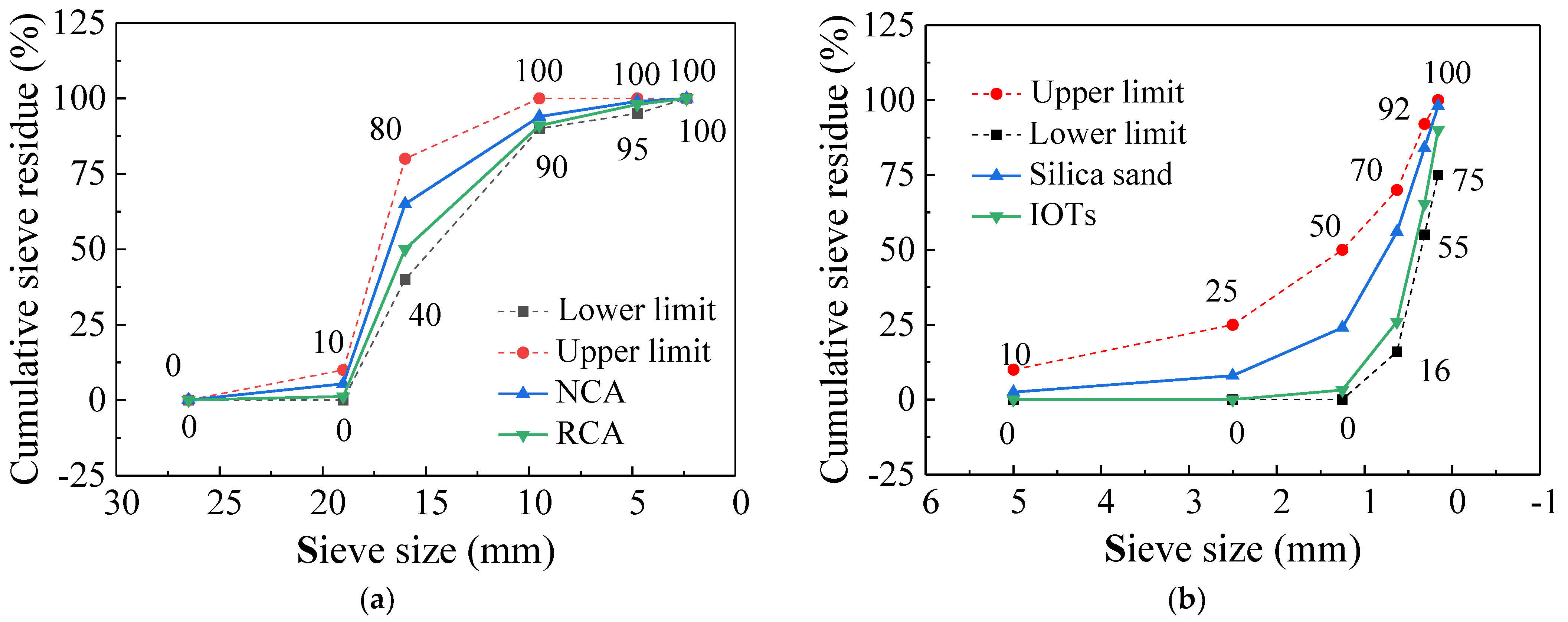
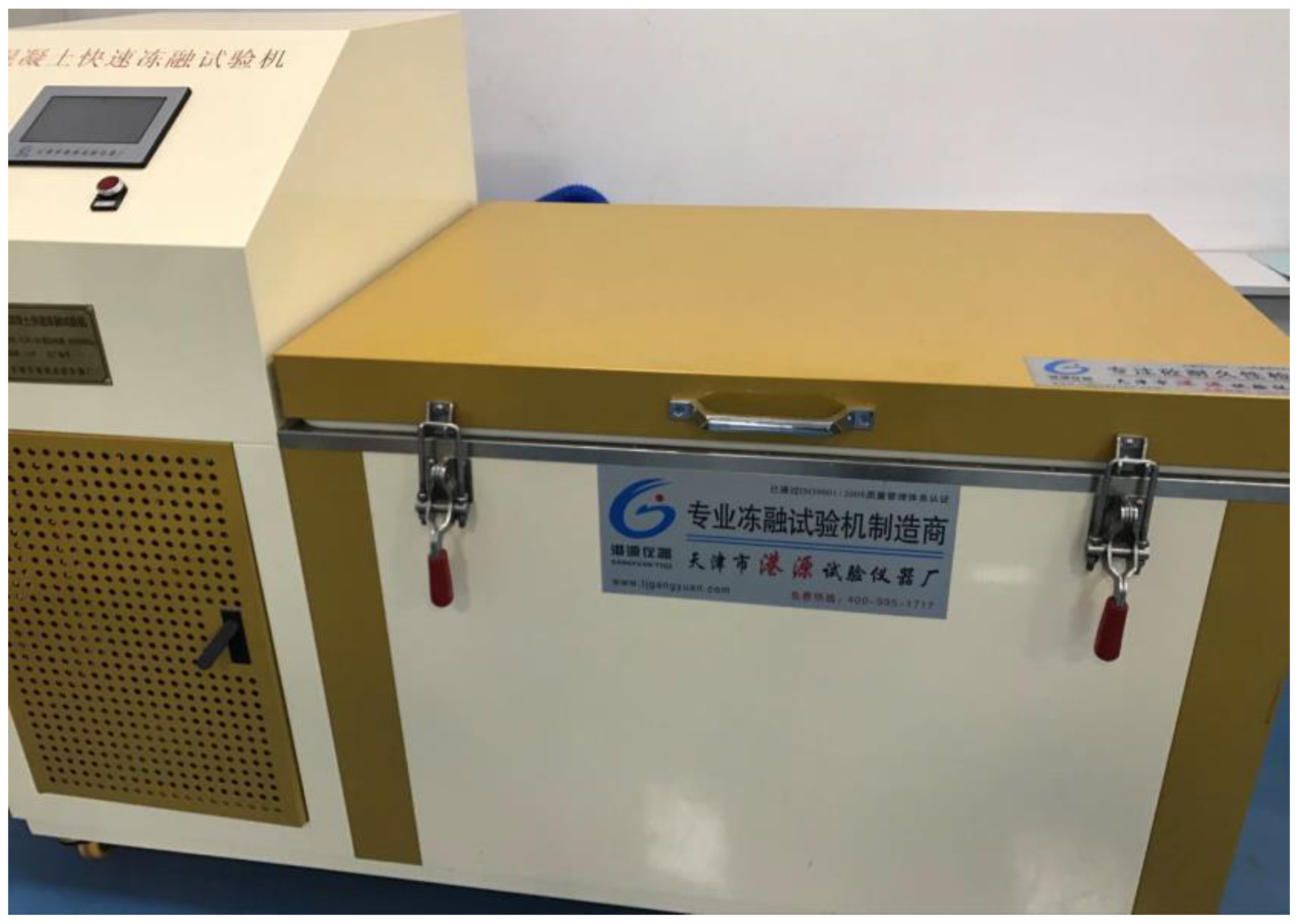
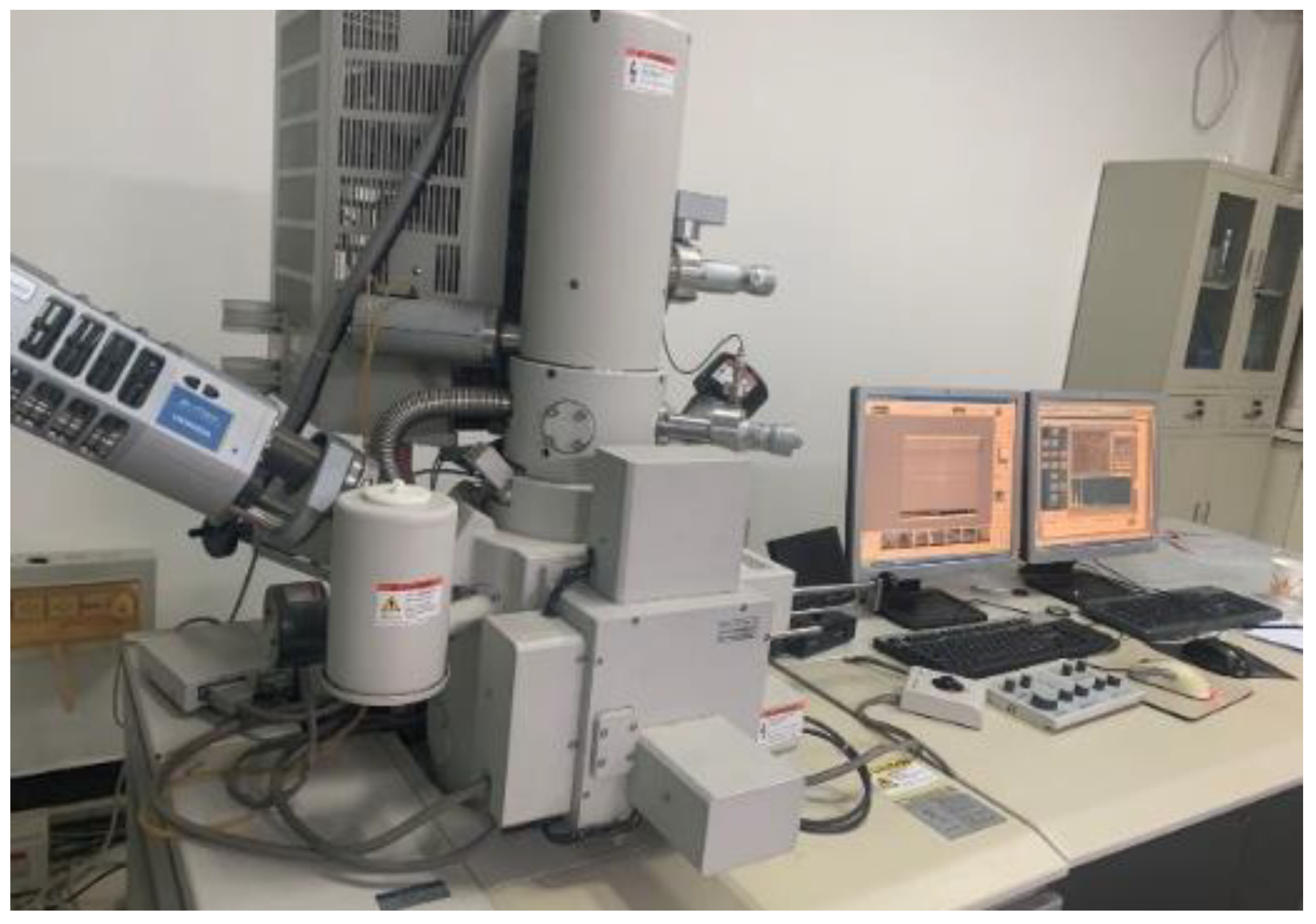
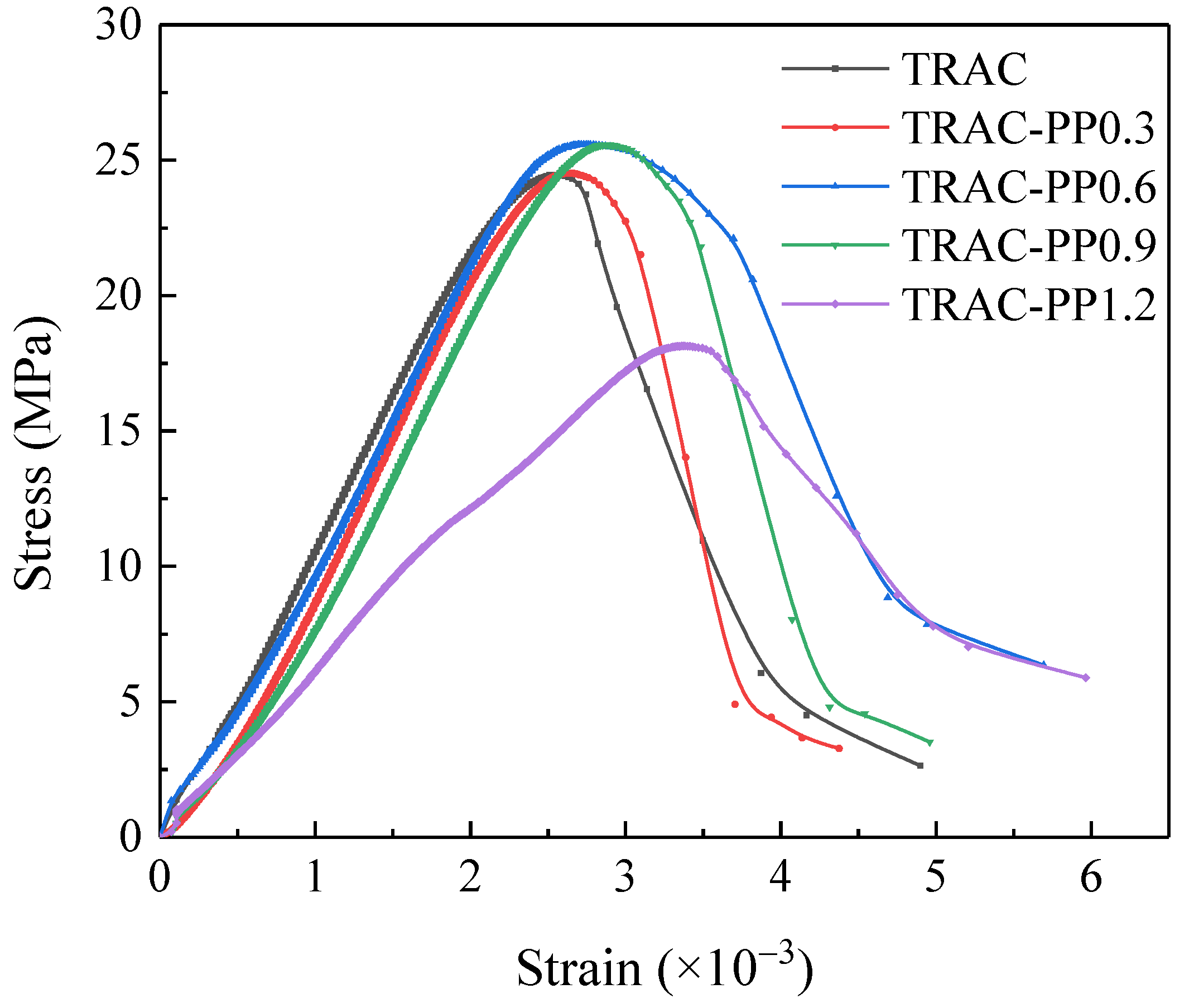
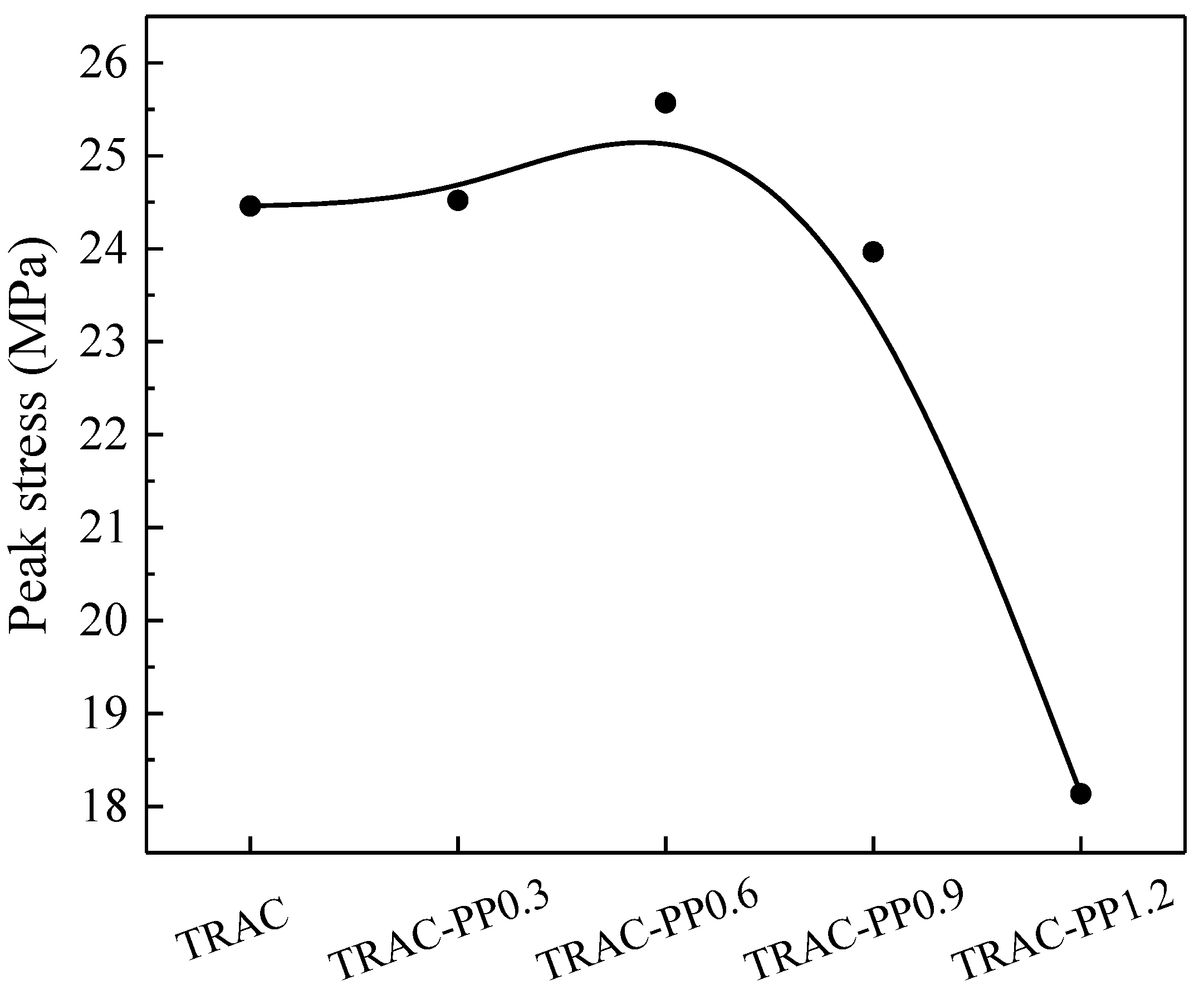


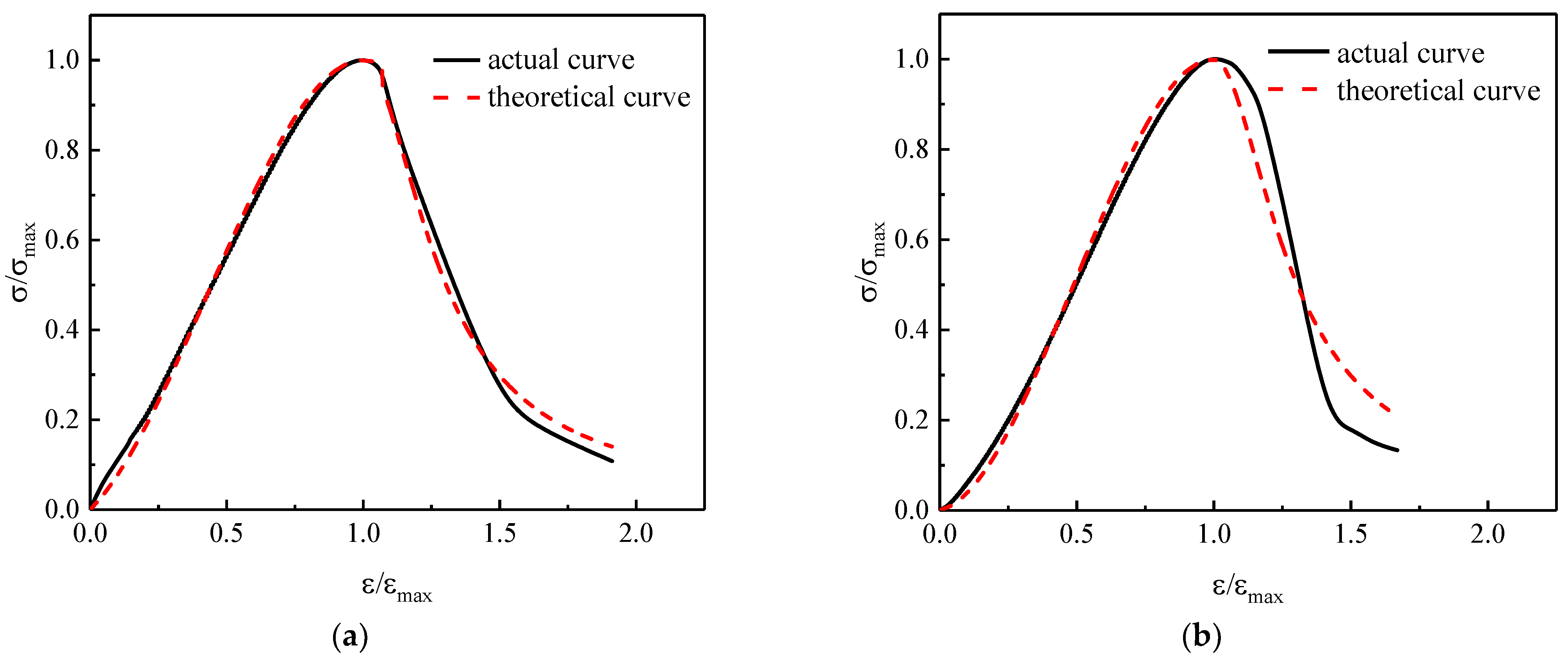


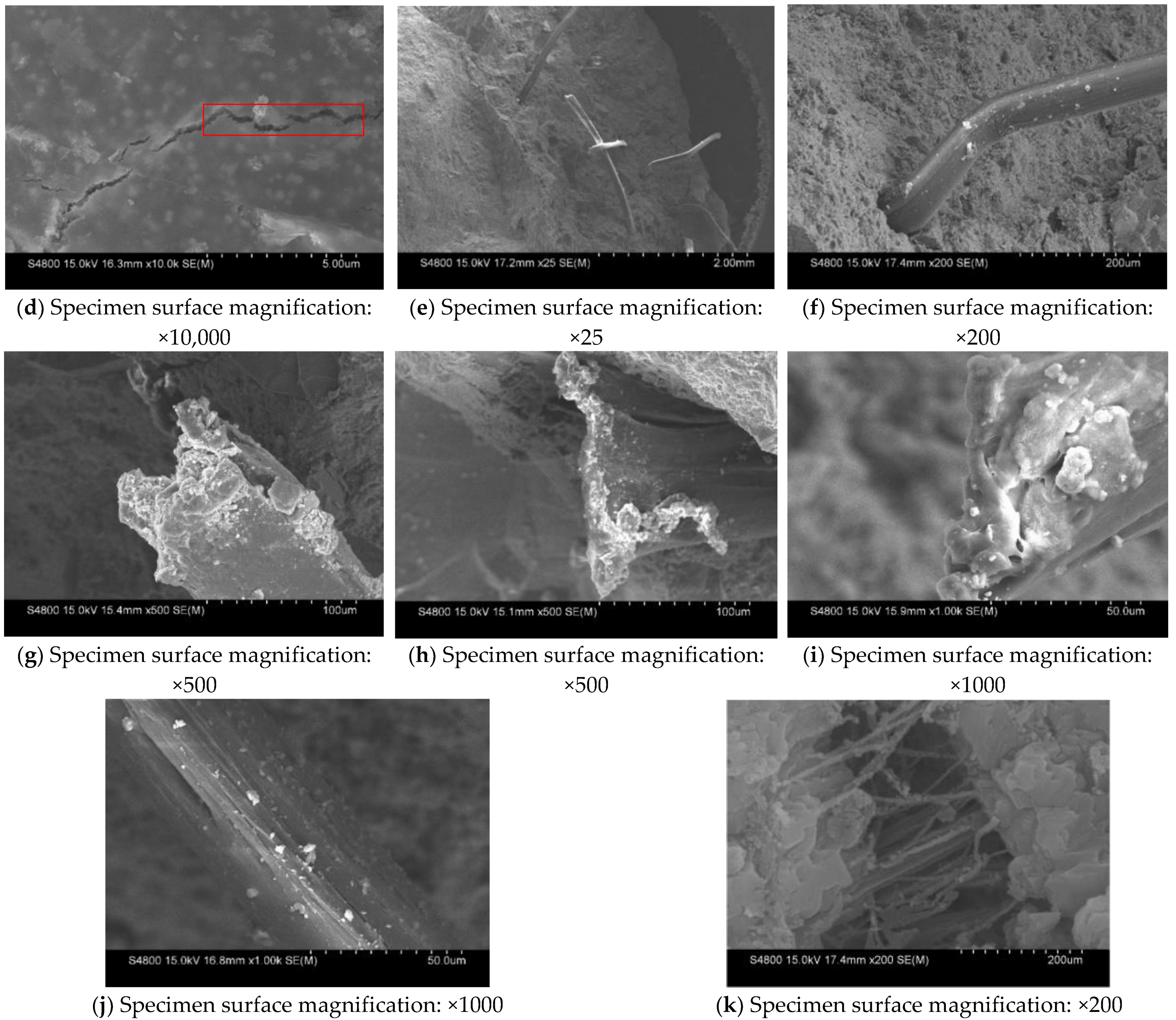
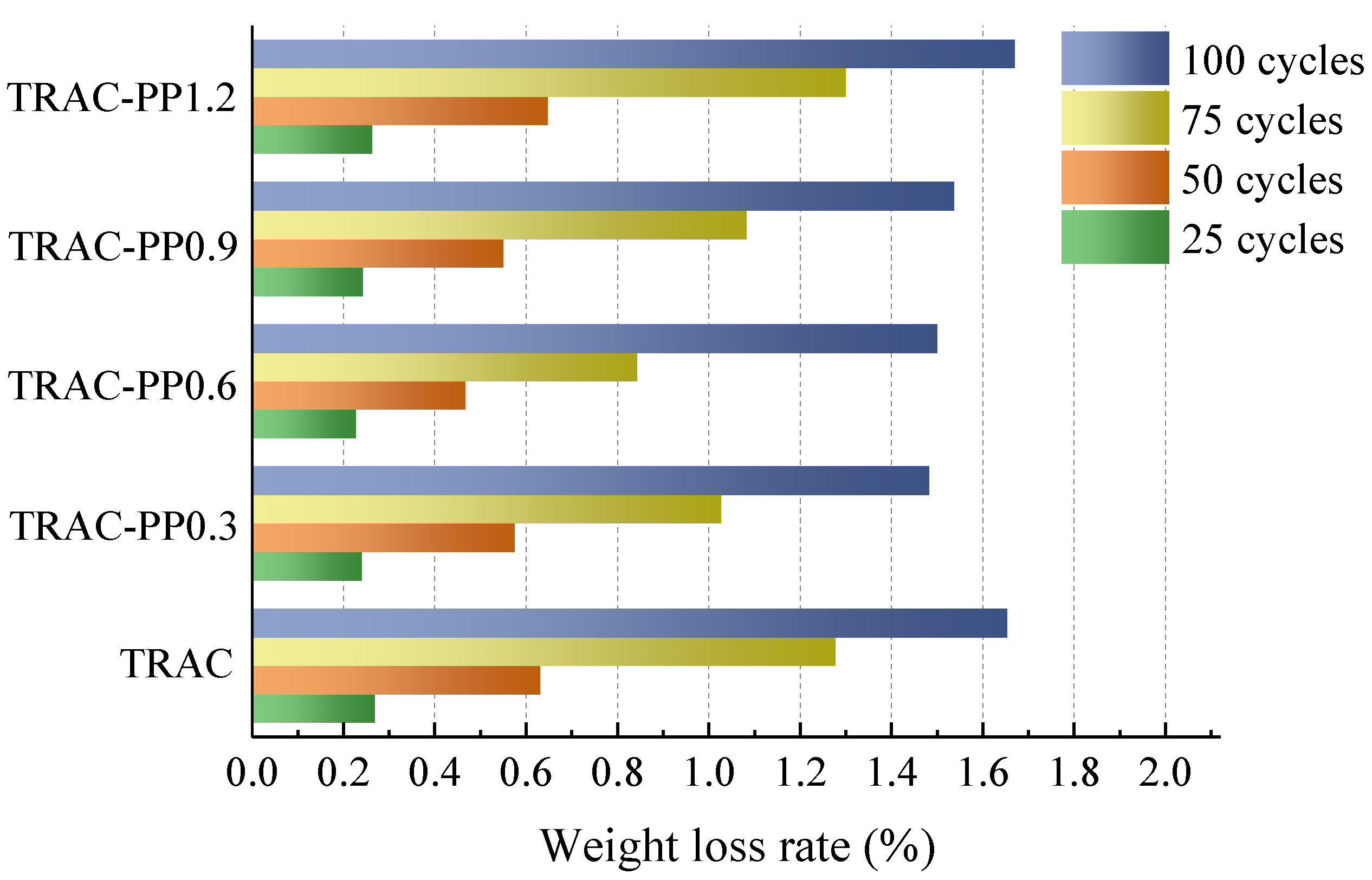
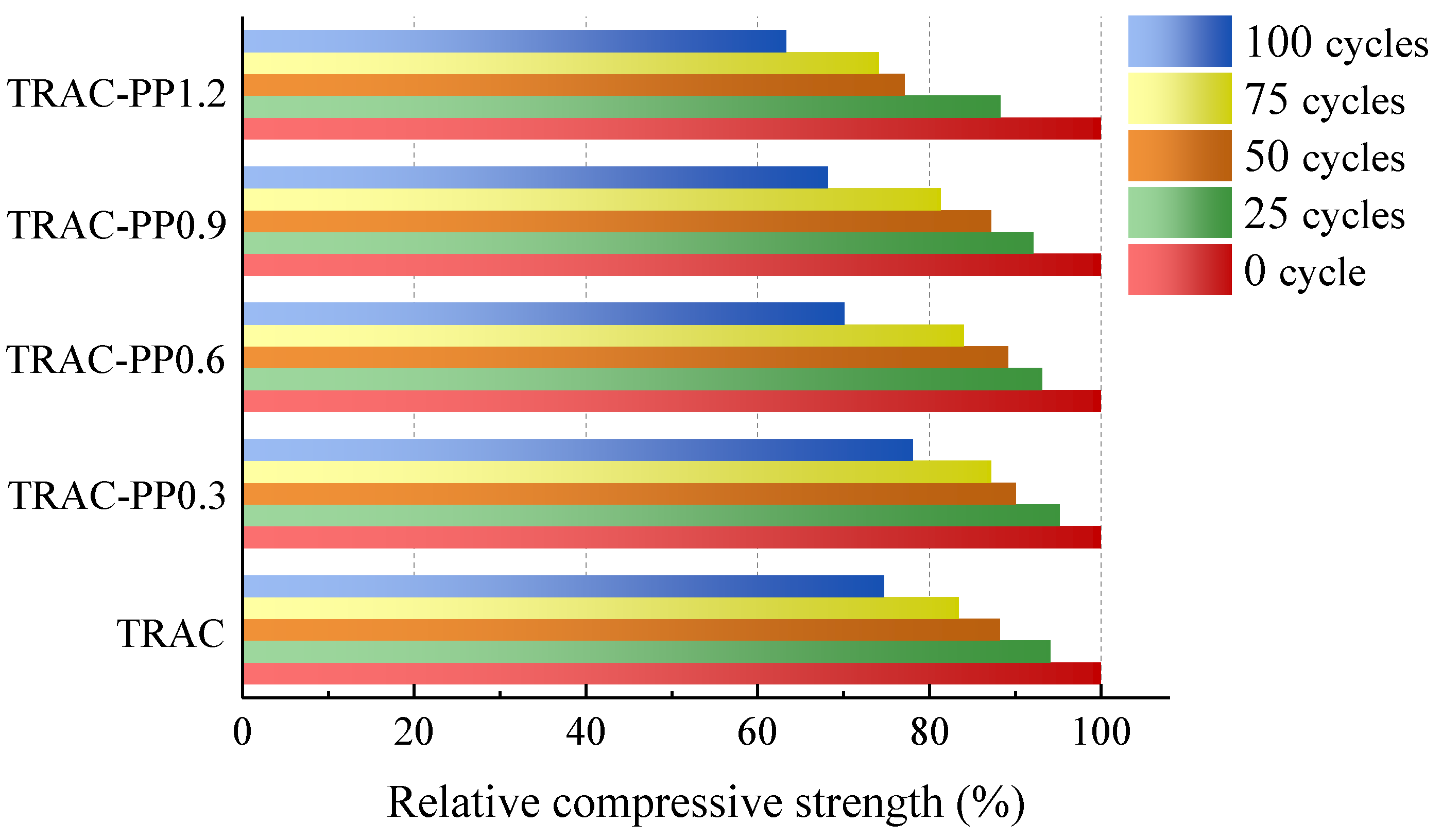
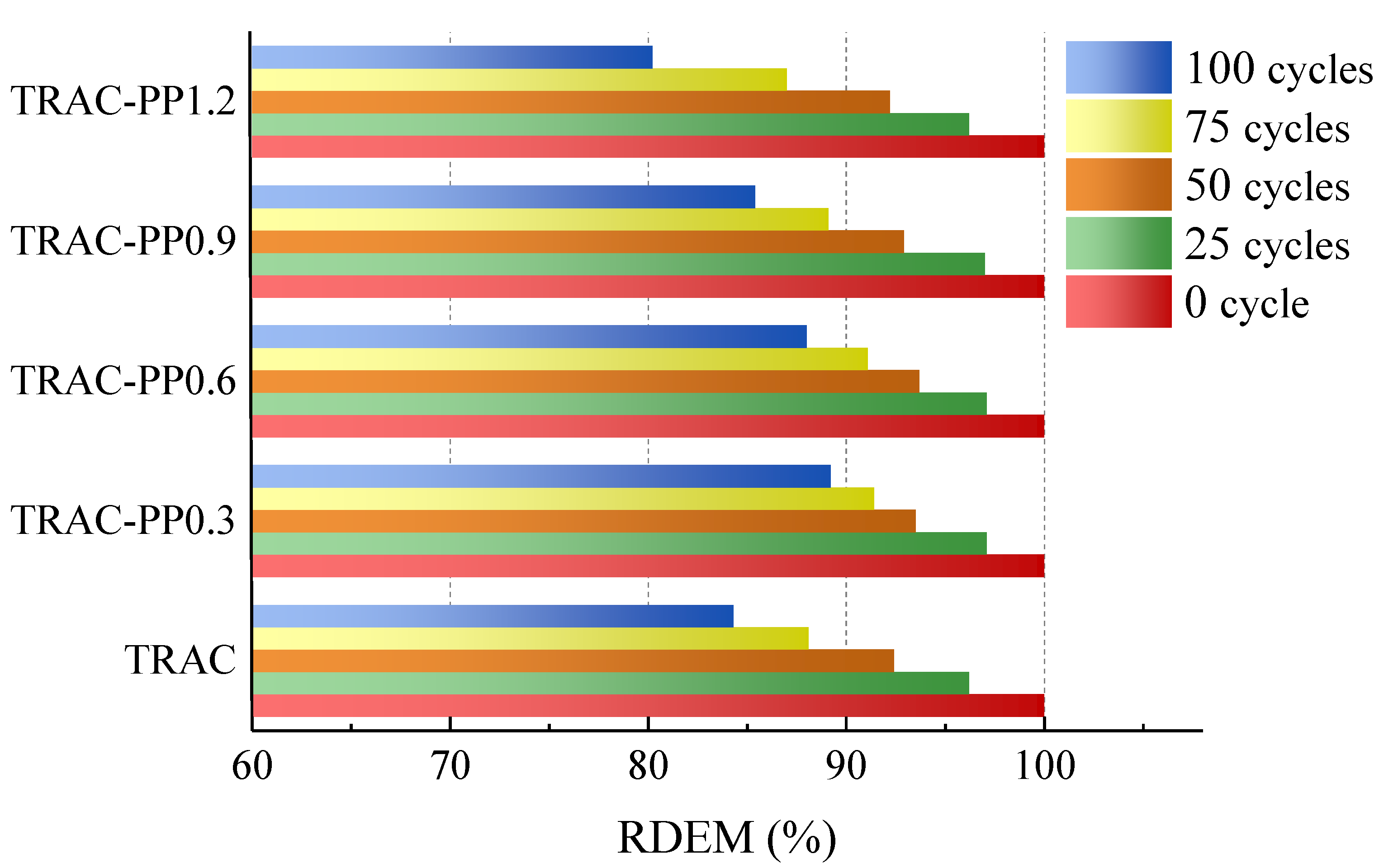
| Aggregate | Apparent Density (kg/m3) | Loose Bulk Density (kg/m3) | Water Absorption (%) | Crushing Index (%) | Mud Content (%) | Water Content (%) |
|---|---|---|---|---|---|---|
| NCA | 2941 | 1749 | 1.33 | 10.3 | 0.72 | 0.8 |
| RCA | 2436 | 1467 | 7 | 14.8 | 1.86 | 3.02 |
| Natural sand | 2764 | 1830 | 2.12 | 12 | 1.2 | 4.1 |
| IOTs | 2745 | 1824 | 8.7 | 19.53 | 2.9 | 1.45 |
| Component | O | Mg | Al | Si | S | K | Ca | Fe | Ti |
|---|---|---|---|---|---|---|---|---|---|
| Silica sand | 60.01 | 0.71 | 2.57 | 32.33 | - | 0.76 | 1.56 | 2.05 | 0 |
| IOTs | 56.49 | 6.95 | 8.38 | 17.46 | - | 3.02 | 1.68 | 5.28 | 0.74 |
| Cement | 47.54 | 0.74 | 1.54 | 6.11 | 1.10 | 0.53 | 56.85 | 0.93 | - |
| Water Requirement for Normal Consistency/% | Initial Setting Time/min | Final Setting Time/min | Fineness Modulus (45 μm) | Stability | Flexural Strength (MPa) | Compressive Strength (MPa) | ||
|---|---|---|---|---|---|---|---|---|
| 3 Days | 28 Days | 3 Days | 28 Days | |||||
| 28 | 160 | 280 | 2.8 | Qualified | 5.2 | 6.8 | 19.5 | 42.2 |
| Specific Gravity (kg/cm3) | Length (mm) | Diameter (mm) | Tensile Strength (MPa) | Breaking Elongation Rate (%) | Elastic Modulus (MPa) |
|---|---|---|---|---|---|
| 1.12 | 22 | 0.08 | >350 | 12–40 | >4000 |
| Specimen | Water (kg/m3) | Ordinary Portland Cement (kg/m3) | NCA (kg/m3) | RCA (kg/m3) | Natural Sand (kg/m3) | IOTs (kg/m3) | PPF (%) |
|---|---|---|---|---|---|---|---|
| TRAC | 215 | 537 | 744 | 319 | 400 | 172 | 0 |
| TRAC-PP0.3 | 215 | 537 | 744 | 319 | 400 | 172 | 0.3 |
| TRAC-PP0.6 | 215 | 537 | 744 | 319 | 400 | 172 | 0.6 |
| TRAC-PP0.9 | 215 | 537 | 744 | 319 | 400 | 172 | 0.9 |
| TRAC-PP1.2 | 215 | 537 | 744 | 319 | 400 | 172 | 1.2 |
| Specimens | TRAC | TRAC-PP0.3 | TRAC-PP0.6 | TRAC-PP0.9 | TRAC-PP1.2 |
|---|---|---|---|---|---|
| 59.02 | 54.71 | 83.91 | 64.67 | 61.57 |
Publisher’s Note: MDPI stays neutral with regard to jurisdictional claims in published maps and institutional affiliations. |
© 2021 by the authors. Licensee MDPI, Basel, Switzerland. This article is an open access article distributed under the terms and conditions of the Creative Commons Attribution (CC BY) license (https://creativecommons.org/licenses/by/4.0/).
Share and Cite
Xu, F.; Li, T.; Li, C.; Li, Z.; Wang, S.; Zhao, N. Compressive Behavior, Microstructural Properties, and Freeze–Thaw Behavior of Tailing Recycled Aggregate Concrete with Waste Polypropylene Fiber Addition. Materials 2021, 14, 6712. https://doi.org/10.3390/ma14216712
Xu F, Li T, Li C, Li Z, Wang S, Zhao N. Compressive Behavior, Microstructural Properties, and Freeze–Thaw Behavior of Tailing Recycled Aggregate Concrete with Waste Polypropylene Fiber Addition. Materials. 2021; 14(21):6712. https://doi.org/10.3390/ma14216712
Chicago/Turabian StyleXu, Fan, Tao Li, Chenghua Li, Zhijun Li, Sheliang Wang, and Nan Zhao. 2021. "Compressive Behavior, Microstructural Properties, and Freeze–Thaw Behavior of Tailing Recycled Aggregate Concrete with Waste Polypropylene Fiber Addition" Materials 14, no. 21: 6712. https://doi.org/10.3390/ma14216712
APA StyleXu, F., Li, T., Li, C., Li, Z., Wang, S., & Zhao, N. (2021). Compressive Behavior, Microstructural Properties, and Freeze–Thaw Behavior of Tailing Recycled Aggregate Concrete with Waste Polypropylene Fiber Addition. Materials, 14(21), 6712. https://doi.org/10.3390/ma14216712








